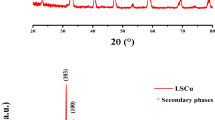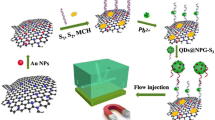Abstract
Rapid and sensitive detection of heavy-metal ions in natural water environments worldwide is urgently needed because of their severe threats to human health. In the present work, monolayer graphite-like flake C3N4 (g-C3N4) materials were applied as a new fluorescent sensor for the detection of trace silver ion in aqueous solution. The thickness of synthesized g-C3N4 was 0.45 nm and obtained by exfoliating twice with ultrasonic. With the presence of ethylene diamine tetraacetic acid as a screening agent, the highly sensitive sensor reached a low detection limit of 52.3 nmol/L for silver (I) ion and there was no disturbance when silver (I) ion coexisted with other metal ions in water samples. Under the optimal conditions, the monolayer g-C3N4 was successfully used to detect trace silver (I) ion in different environmental water and drinking water samples.





Similar content being viewed by others
References
Dastafkan K, Khajeh M, Ghaffari-Moghaddam M, Bohlooli M (2015) Silver nanoparticles for separation and preconcentration processes. TrAC-Trends Anal. Chem. 64:118–126
Greulich C, Braun D, Peetsch A, Diendorf J, Siebers B, Epple M, Koller M (2012) The toxic effect of silver ions and silver nanoparticles towards bacteria and human cells occurs in the same concentration range. RSC Adv 2:6981–6987
Mohammadi SZ, Afzali D, Heshmati Z (2013) Ligand-less in situ surfactant-based solid phase extraction for preconcentration of silver from natural water samples prior to its determination by atomic absorption spectroscopy. Toxico. Environ. Chem. 95:1299–1308
Poitras EP, Levine MA, Harrington JM, Essader AS, Fennell TR, Snyder RW, Black SL, Sumner SS, Levine KE (2015) Development of an analytical method for assessment of silver nanoparticle content in biological matrices by inductively coupled plasma mass spectrometry. Biol Trace Elem Res 163:184–192
Zhang JF, Zhou Y, Yoon J, Kim JS (2011) Recent progress in fluorescent and colorimetric chemosensors for detection of precious metal ions (silver, gold and platinum ions). Chem Soc Rev 40:3416–3429
Singha S, Kim D, Seo H, Cho SW, Ahn KH (2015) Fluorescence sensing systems for gold and silver species. Chem Soc Rev 44:4367–4399
Lee J, Park J, Lee HH, Park H, Kim HI, Kim WJ (2015) Fluorescence switch for silver ion detection utilizing dimerization of DNA-Ag nanoclusters. Biosens. Bioelectron. 68:642–647
Afkhami A, Shirzadmehr A, Madrakian T, Bagheri H (2015) New Nano-composite potentiometric sensor composed of graphene nanosheets/thionine/molecular wire for nanomolar detection of silver ion in various real samples. Talanta 131:548–555
Huang K, Xu KL, Tang J, Yang L, Zhou JR, Hou XD, Zheng CB (2015) Room temperature cation exchange reaction in nanocrystals for ultrasensitive speciation analysis of silver ions and silver nanoparticles. Anal Chem 87:6584–6591
Xu WG, Wang X, Cai ZW (2013) Analytical chemistry of the persistent organic pollutants identified in the Stockholm convention: a review. Anal Chim Acta 790:1–13
Vazquez-Gonzalez M, Carrillo-Carrion C (2014) Analytical strategies based on quantum dots for heavy metal ions detection. J. Biomed. Optics 19:101503
Li XF, Li M, Yang JH, Li XY, Hu TJ, Wang JS, Sui YR, Wu XT, Kong LN (2014) Synergistic effect of efficient adsorption g-C3N4/ZnO composite for photocatalytic property. J. Phy. Chem. Solids 75:441–446
Li YH, Sun YJ, Dong F, Ho WK (2014) Enhancing the photocatalytic activity of bulk g-C3N4 by introducing mesoporous structure and hybridizing with graphene. J. Colloid Interf. Sci. 436:29–36
Zhang XD, Xie X, Wang H, Zhang JJ, Pan BC, Xie Y (2013) Enhanced photoresponsive ultrathin graphitic-phase C3N4 nanosheets for bioimaging. J Am Chem Soc 135:18–21
Lee EZ, Jun YS, Hong WH, Thomas A, Jin MM (2010) Cubic mesoporous graphitic carbon(IV) nitride: an all-in-one chemosensor for selective optical sensing of metal ions. Angew Chem Int Ed 49:9706–9710
Barman S, Sadhukhan M (2012) Facile bulk production of highly blue fluorescent graphitic carbon nitride quantum dots and their application as highly selective and sensitive sensors for the detection of mercuric and iodide ions in aqueous media. J Mater Chem 22:21832
Lee EZ, Lee SU, Heo NS, Stucky GD, Jun YS, Hong WH (2012) A fluorescent sensor for selective detection of cyanide using mesoporous graphitic carbon (IV) nitride. Chem Commun 48:3942–3944
Wang Y, Wang XC, Antonietti M (2012) Polymeric graphitic carbon nitride as a heterogeneous organocatalyst: from photochemistry to multipurpose catalysis to sustainable chemistry. Angew Chem Int Ed 51:68–89
Tian JQ, Liu Q, Asiri MA, Al-Youbi AO (2013) Ultrathin graphitic carbon nitride nanosheet: a highly efficient fluorosensor for rapid, ultrasensitive detection of Cu2+. Anal Chem 85:5595–5599
Zhang XL, Zheng C, Guo SS, Li J, Yan H, Chen G (2014) Turn-on fluorescence sensor for intracellular imaging of glutathione using g-C3N4 nanosheet–MnO2 sandwich nanocomposite. Anal Chem 86:3426–3434
Novoselov KS, Geim AK, Morozov SV, Jiang D, Zhang Y, Dubonos SV, Grigorieva IV, Firsov AA (2004) Electric field effect in atomically thin carbon films. Science 306:666–669
Goettmann F, Fischer A, Antonietti M, Thomas A (2006) Chemische synthese von mesoporösen kohlenstoffnitriden in harten templaten und ihre anwendung als metallfreie katalysatoren in friedel-crafts-reaktionen. Angew Chem 118:4579–4583
Haris DC (2010) Quantitative chemical analysis (8th). Clancy Marshall, NY
Acknowledgments
We are grateful to Dr. Xiao-hua Xiao from Sun Yat-sen University for his helpful advice. This work was supported by the National Natural Science Foundation of China (No.21275056).
Author information
Authors and Affiliations
Corresponding author
Rights and permissions
About this article
Cite this article
Cao, Y., Wu, W., Wang, S. et al. Monolayer g-C3N4 Fluorescent Sensor for Sensitive and Selective Colorimetric Detection of Silver ion from Aqueous Samples. J Fluoresc 26, 739–744 (2016). https://doi.org/10.1007/s10895-016-1764-9
Received:
Accepted:
Published:
Issue Date:
DOI: https://doi.org/10.1007/s10895-016-1764-9




